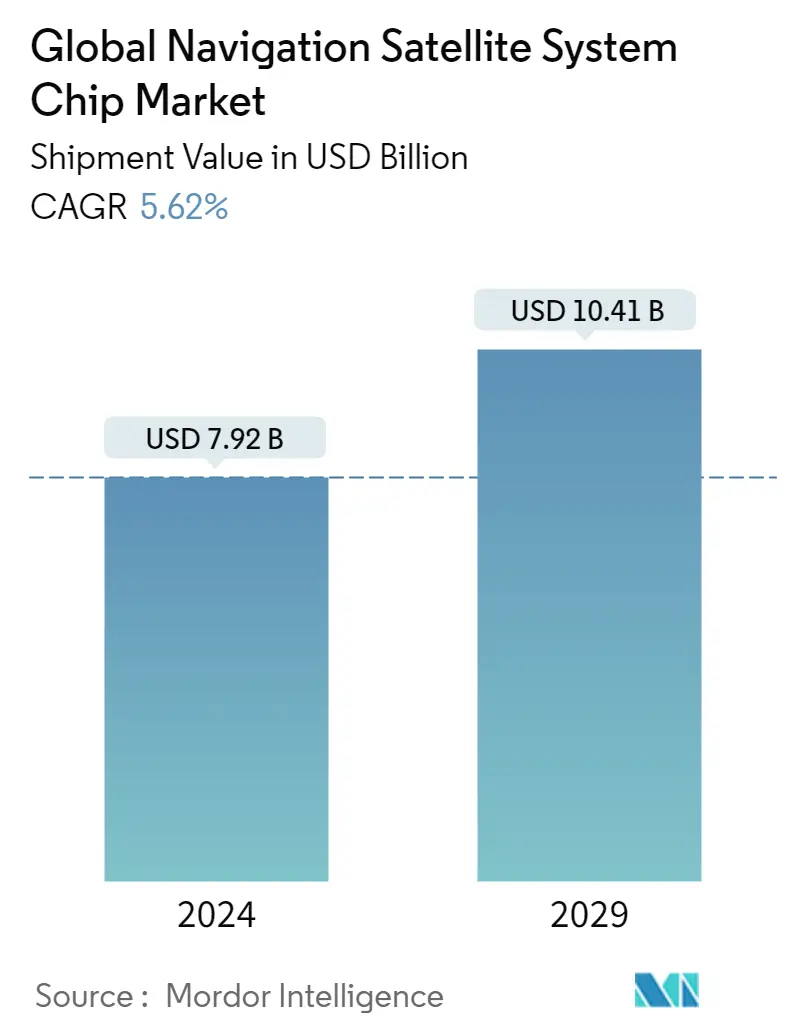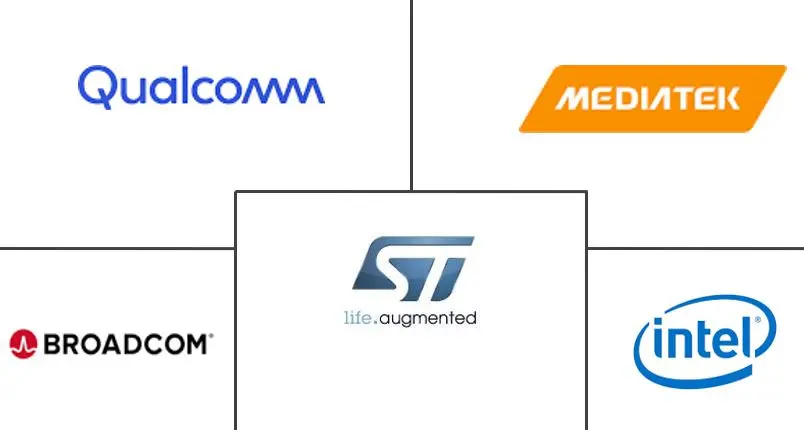Market Size of Global Navigation Satellite System Chip Industry

| Study Period | 2019 - 2029 |
| Market Size (2024) | USD 7.92 Billion |
| Market Size (2029) | USD 10.41 Billion |
| CAGR (2024 - 2029) | 5.62 % |
| Fastest Growing Market | Asia Pacific |
| Largest Market | Asia-Pacific |
| Market Concentration | Low |
Major Players
*Disclaimer: Major Players sorted in no particular order |
Global Navigation Satellite System (GNSS) Chip Market Analysis
The Global Navigation Satellite System Chip Market size in terms of shipment value is expected to grow from USD 7.92 billion in 2024 to USD 10.41 billion by 2029, at a CAGR of 5.62% during the forecast period (2024-2029).
The outbreak of the COVID-19 pandemic significantly disrupted the supply chain and production of semiconductors in the initial phase of 2020. For multiple chipmakers, the impact was more severe. Due to labor shortages, many packages and testing plants in the Asia-Pacific region reduced or even suspended operations. This also created a bottleneck for end-product companies that depend on semiconductors.
Global navigation satellite system (GNSS) essentially refers to the constellation of satellites that provide signals from space, transmit positioning, and data timing to the GNSS receivers. The receivers then use such data to determine various factors, such as location, speed, and altitude, combined with several sensors.
The precision and accuracy of such chips are primarily dependent on the satellites in the visibility range. As a result, multiple countries are eagerly trying to deploy regional constellations for better navigation and mapping. However, in the market, only five countries (China, Russia, the United States, India, and Japan) and the European Union have their GNSS systems.
GNSS users expect near-instantaneous position sharing speeds. This is often impossible with standard positioning as at least four satellites must be identified, and their complete data should be received. In adverse signal conditions or harsh environments, transmitting and receiving data can take minutes, hours, or even fail. However, the performance can be improved by integrating the GNSS receiver data with information from mobile network cells to benefit numerous applications in the IoT industry.
In January 2021, U-Blox announced its ALEX - R5 module, which integrates low-power wide-area (LPWA) cellular communication and GNSS technology into the system-in-package. The two key elements are the company's UBX - R5 LTE - M/NB-IoT chipset with a secure cloud functionality and the U-Blox M8 GNSS chip for adequate location accuracy for healthcare applications.
The increasing volume of consumer electronics equipped with navigation and positioning features is expected to create a considerable demand for low-power GNSS chips. Technologically advanced wearable devices are in the demand trend currently. At present, almost 50% of the global population has been using tech-advanced wearable devices, such as fitness bands and smartwatches. GNSS chips are majorly being integrated into these devices to give precise locations to the user even while running, walking, or driving, allowing them to stay connected with their close ones.
In August 2020, Sony Corporation announced the release of high-precision GNSS receiver LSIs for IoT and wearable devices. The new LSIs support the conventional L1 band reception and L5 band reception, which are currently being expanded across GNSS constellations, making them suitable for dual-band positioning.
Global Navigation Satellite System (GNSS) Chip Industry Segmentation
A global navigation satellite system (GNSS) primarily refers to a constellation of satellites, which provides signals from space that transmit positioning and timing data to GNSS receivers. The receivers then use this data to determine various factors, such as location, speed, and altitude, combined with several sensors. The study covers the market numbers and unit shipments based on device type and uses of GNSS in different end-user industries across various geographies. Further, the study also covers the impact of the COVID-19 pandemic on the market.
| Device Type | |
| Smartphones | |
| Tablets and Wearables | |
| Personal Tracking Devices | |
| Low-power Asset Trackers | |
| In-vehicle Systems | |
| Drones | |
| Other Device Types |
| End-user Industry | |
| Automotive | |
| Consumer Electronics | |
| Aviation | |
| Other End-user Industries |
| Geography | |||||
| |||||
| |||||
| |||||
| Latin America | |||||
| Middle-East and Africa |
Global Navigation Satellite System Chip Market Size Summary
The GNSS chip market is poised for significant growth, driven by the increasing integration of navigation and positioning features in consumer electronics and the expanding IoT industry. The market is characterized by the deployment of global navigation satellite systems, which rely on satellite constellations to provide precise positioning and timing data to GNSS receivers. Despite challenges such as supply chain disruptions during the COVID-19 pandemic, the market is expected to expand as countries enhance their GNSS capabilities and as demand for low-power, high-accuracy chips rises, particularly in wearable devices and smartphones. The market landscape is competitive, with key players like Qualcomm, Mediatek, and STMicroelectronics actively pursuing strategic partnerships and technological advancements to capture market share.
The regulatory environment, particularly in the European Union, is also influencing market dynamics by mandating GNSS capabilities in new smartphones, thereby increasing the adoption of Galileo-compatible chipsets. This regulatory push, combined with technological innovations such as dual-frequency GNSS chips and the integration of GNSS with mobile network data, is expected to enhance positioning accuracy and open new applications in various sectors. Additionally, initiatives in regions like China and Korea to develop and expand their GNSS systems further underscore the global emphasis on navigation technology. As the market evolves, the focus on R&D and innovation remains crucial, with companies continuously striving to improve chip performance and reduce power consumption, thereby catering to the growing demand for advanced navigation solutions.
Global Navigation Satellite System Chip Market Size - Table of Contents
-
1. MARKET INSIGHTS
-
1.1 Market Overview
-
1.2 Industry Attractiveness - Porter's Five Forces Analysis
-
1.2.1 Bargaining Power of Suppliers
-
1.2.2 Bargaining Power of Consumers
-
1.2.3 Threat of New Entrants
-
1.2.4 Threat of Substitute Products
-
1.2.5 Intensity of Competitive Rivalry
-
-
1.3 Industry Value Chain Analysis
-
1.4 Assessment of the Impact of the COVID-19 Pandemic on the Market
-
-
2. MARKET SEGMENTATION
-
2.1 Device Type
-
2.1.1 Smartphones
-
2.1.2 Tablets and Wearables
-
2.1.3 Personal Tracking Devices
-
2.1.4 Low-power Asset Trackers
-
2.1.5 In-vehicle Systems
-
2.1.6 Drones
-
2.1.7 Other Device Types
-
-
2.2 End-user Industry
-
2.2.1 Automotive
-
2.2.2 Consumer Electronics
-
2.2.3 Aviation
-
2.2.4 Other End-user Industries
-
-
2.3 Geography
-
2.3.1 North America
-
2.3.1.1 United States
-
-
2.3.2 Europe
-
2.3.2.1 Russia
-
-
2.3.3 Asia-Pacific
-
2.3.3.1 China
-
2.3.3.2 Japan
-
2.3.3.3 South Korea
-
-
2.3.4 Latin America
-
2.3.5 Middle-East and Africa
-
-
Global Navigation Satellite System Chip Market Size FAQs
How big is the Global Navigation Satellite System Chip Market?
The Global Navigation Satellite System Chip Market size is expected to reach USD 7.92 billion in 2024 and grow at a CAGR of 5.62% to reach USD 10.41 billion by 2029.
What is the current Global Navigation Satellite System Chip Market size?
In 2024, the Global Navigation Satellite System Chip Market size is expected to reach USD 7.92 billion.

